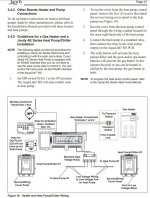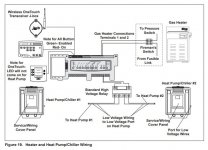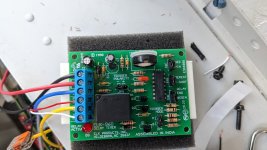Hi there, been lurking here for a while trying to find out how to do this but cannot figure it out.
I just had a new RayPak 8450 heat pump installed with a 3 way diverter bypass valve for the inlet and check valve on the outlet.
The problem is that even if the heat pump is off, if water is flowing through it, it seriously reduces the flow at current VSP (Jandy 2.7HP) speed of 2750. It looks like I'd have to max out to 3500 to get it to the same flow level. If I bypass the heat pump, it flows the same as before the heat pump was installed.
What I'd like to do is to only send water through the heater when it's actually heating, and then bypass it at other times. Similar to what the guy in this post did: AquaLink RS8 and Heater Control where he was also able to introduce a timer delay to allow for the cool down function to run on the Aqualink.
I have a JVA that I could install on top of the diverter valve for the heat pump but I can't figure out where I'd get a trigger signal from for his device since I'm using the fireman's switch on the low voltage heater terminals for remote control of the RayPak.
It would be great if this could all be done natively in the Aqualink but I can't see where to do it. I was able to control the JVA from the heat pump button in the iAqualink web app, but it looks like this operates independently from the Pool/Spa heat modes.
I have dip switches S1.8 set to on and S2.1 set to on. Thanks for any help!
System specs:
Aqualink RS4 (IQ904-PS bundle)
RayPak 8450-Ti-E
Jandy VS FloPro 2.7HP
Hayward AquaRite AQR15 Chlorinator
I just had a new RayPak 8450 heat pump installed with a 3 way diverter bypass valve for the inlet and check valve on the outlet.
The problem is that even if the heat pump is off, if water is flowing through it, it seriously reduces the flow at current VSP (Jandy 2.7HP) speed of 2750. It looks like I'd have to max out to 3500 to get it to the same flow level. If I bypass the heat pump, it flows the same as before the heat pump was installed.
What I'd like to do is to only send water through the heater when it's actually heating, and then bypass it at other times. Similar to what the guy in this post did: AquaLink RS8 and Heater Control where he was also able to introduce a timer delay to allow for the cool down function to run on the Aqualink.
I have a JVA that I could install on top of the diverter valve for the heat pump but I can't figure out where I'd get a trigger signal from for his device since I'm using the fireman's switch on the low voltage heater terminals for remote control of the RayPak.
It would be great if this could all be done natively in the Aqualink but I can't see where to do it. I was able to control the JVA from the heat pump button in the iAqualink web app, but it looks like this operates independently from the Pool/Spa heat modes.
I have dip switches S1.8 set to on and S2.1 set to on. Thanks for any help!
System specs:
Aqualink RS4 (IQ904-PS bundle)
RayPak 8450-Ti-E
Jandy VS FloPro 2.7HP
Hayward AquaRite AQR15 Chlorinator




